WINTER’S LEGACY, STILL
/2 Comments/in Fruit, Gardening, Vegetables/by Lee ReichHalf a Pear, Tree
Perhaps last winter’s weather — extended cold, but not frigid temperatures, and hardly any snow — is still playing games with us. Perhaps it is mischief from the early, extended, very warm weather in early spring that was followed by plummeting temperatures and our biggest snowfall (4 inches) of the year. Whatever the reason, some weird things are going on this growing season.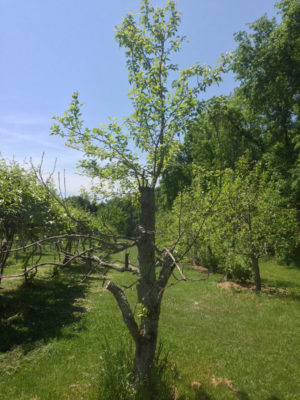
Look at one of my old pear trees, for instance. This tree might be called my “sample” or my “first cut” pear tree. When I hear tell of a pear variety that might be worth growing, I get a scion and graft it onto this tree. The scion bears quickly, in theory, at least, and, if it passes the “first cut,” perhaps it will warrant its own tree. There’s not enough time or space to put every Tom, Dick, and Harry of a pear variety on its own tree.
The tree now has about a dozen varieties of pear growing off various branches. That’s not weird, though. What is weird is that, right now, the top half of the tree is fully leafed out while limbs on the bottom half of the tree are leafless.
A disease? Doubtful. A disease killing that much of a tree at once would probably originate in the trunk or roots, in which case the whole tree or only the upper portion would be leafless. And anyway, those leafless limbs are not dead. Cutting beneath the bark reveals living, green tissue.
My hypothesis — a weak one — is that the cold snap in spring, where temperatures in the ‘teens followed a spate of temperatures in the 70’s, is the culprit. Warm temperatures in late winter and spring cause plants to rapidly awaken and lose the cold-hardiness they maintained through the coldest parts of winter. The pears seemed quite awake when that cold spell struck.
But why was only the bottom portion of the tree affected? (Here’s the weakness in my hypothesis.) Windless, clear nights, such as during spring’s cold snap, bring a temperature inversion. Under such conditions, denser cold air can settle down near ground level. Even a few feet of elevation can make a difference, one that’s evident when riding a bicycle or motorcycle on a clear summer night on rolling terrain.
So maybe the bottom half of the pear tree experienced temperatures just below the tipping point where enough damage occurred to delay leafing out.
Other Pear Trees, Still Whole
No other plants, including other pear trees, experienced this bifurcation. Then again, the “sample” pear is all by itself where the microclimate might be slightly different.
During that cold snap, the other pears were quite awake, seemingly just about ready to spread their blossoms. I was braced for a total crop loss. Weirdly, the trees went on to blossom just fine and now have what’s shaping up to be a decent load of fruit on them.
Seedling Troubles
More weirdness: Every season I sow vegetable seeds according to a schedule I’ve developed over the years. I sow the seeds in mini-furrows in flats of potting soil or potting soil topped with a mix of peat moss and perlite. Every season I make my own potting soil from a mix of equal parts peat moss, perlite, compost, and garden soil, with everything sifted together through half-inch mesh hardware cloth.
 And every season I’ve had sturdy, lush green transplants to set out over the past few weeks. Not this season. Too many of the transplants are stunted, with flaccid leaves that are not uniformly lush green. Some have slight, interveinal yellowing of oldest leaves, some have slight reddening of veins, hinting, respectively, at insufficient nitrogen and phosphorus uptake .
And every season I’ve had sturdy, lush green transplants to set out over the past few weeks. Not this season. Too many of the transplants are stunted, with flaccid leaves that are not uniformly lush green. Some have slight, interveinal yellowing of oldest leaves, some have slight reddening of veins, hinting, respectively, at insufficient nitrogen and phosphorus uptake .
As usual, the weather could be blamed. Those auspicious, sunny days of late winter gave way to a long period of overcast days. Rain or not is not the issue because seedlings were in the greenhouse, watered as needed. Overwatered? Underwatered? Cool greenhouse temperatures could limit root growth, in turn limiting uptake of nutrients even if they are in the soil.
The potting soil could be the culprit. Although ingredients of my mix are always proportionately the same, the compost isn’t exactly the same from year to year. Same goes for the “garden soil” that goes into the mix. I scrape it up from various places around the yard: the bottom of a finished compost bin, from my catch-all extra soil bin, from top layers of a pond I’m occasionally hand-digging.
A couple of other gardeners and farmers have concurred with their seedlings’ poor growth this year. Perhaps it was the weather? Do you want to weigh in?
And the Winner Is . . .
Very few people offered hypotheses on why only one limb of my plum tree was in bloom. Neither the weather nor any other environmental condition was to blame. In fact, I had grafted the tree a few years ago to four different varieties in order to spread out the harvest date and offer a greater variety of plum flavors.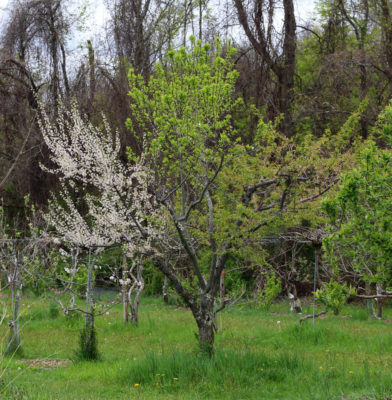
The bulk of the tree had already flowered.The one blooming branch was that of beach plum, the least reliable, smallest, and, to my taste, least flavorful of the lot. Perhaps I’ll graft that limb over to yet another variety.
Congratulations to Tom, tkjazzer@gmail.com, on winning a copy of my book Grow Fruit Naturally.
MAKING SCENTS (AND A BOOK GIVE AWAY!)
/8 Comments/in Books, Flowers, Fruit, Gardening, Pruning/by Lee ReichReader Alert: Invasive Plant
The sweet scent practically bowled me over. My friend, walking with me along the nearby rail trail, characterized the aroma as citrus-y rather than sweet. Either way, the aroma was delicious and welcome. Too bad the source of the scent, autumn olive (Elaeagnus umbellata), is a plant so reviled.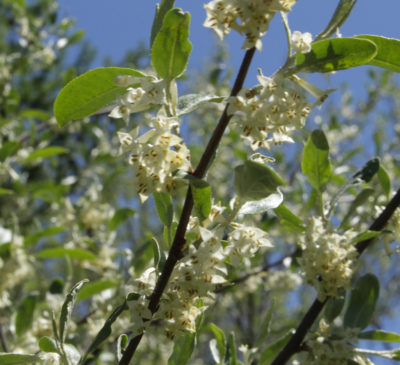
“Too bad” because the plant also has other qualities. The olive-green leaves lend a Mediterranean feel to any setting. Microorganisms associated with the shrub’s roots garner nitrogen from the air to enrich the soil. And come early fall, the plants are loaded with delicious and nutritious, small, red (sometimes yellow) berries.
Alas, this non-native plant grows too easily, frequenting fields and waysides. It’s deemed invasive, which it is . . . but?
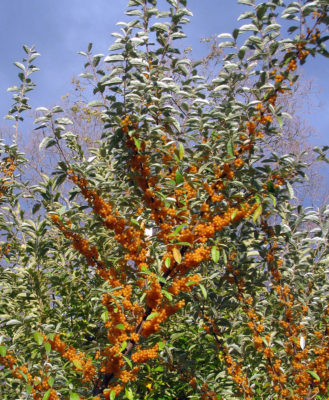 (Autumn olive is often confused with Russian olive, E. angustifolium, a close relative that is more tree-like, less invasive, and with sweet, olive-green fruits. Another equally attractive, fragrant, tasty, and soil-building plant is gumi, E. multiflora, not well known but closely related to the other “olives.”)
(Autumn olive is often confused with Russian olive, E. angustifolium, a close relative that is more tree-like, less invasive, and with sweet, olive-green fruits. Another equally attractive, fragrant, tasty, and soil-building plant is gumi, E. multiflora, not well known but closely related to the other “olives.”)
And Yet Another Invasive
Soon, by the time you read this, the rail trail and elsewhere will be suffused by another pleasant aroma, that of honeysuckle. These flowers are also followed by red berries, but they’re not edible. (Other honeysuckle species do yield edible berries, an up and coming fruit called haskaps.)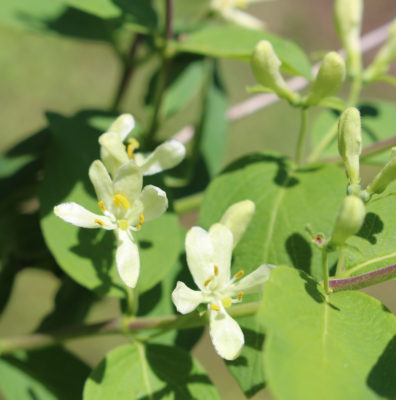
How could anyone not like a plant with a name like “honeysuckle?” A lot of people don’t like honeysuckle because it too, despite its qualities, is invasive.
You Call This Renovation
Before anyone attacks me for heaping praise on invasive plants, let’s sidle off the rail trail and back to the home front, where yet another delicious scent fills the air. This one wafts from a plant that, unlike autumn olive, Russian olive, and gumi, is not invasive and is truly in the olive family: lilac (Syringa vulgaris).
Actually, for years now, my lilac bush has not been perfuming the air as much as it should. The plant is old, my guess is over 50 years old. Not that age alone is responsible for its poor showing. Lilac, like other shrubs, have long-lived root systems. No stem ever develops into a permanent, long-lived trunk and — important for all flowering and fruiting shrubs — after a certain age stems can’t keep up the flower production of its youth.
The way to prune any flowering or fruiting shrub is by a renewal method. You cut down some of the oldest stems that are no longer performing well. And then you thin out — that is, reduce the number of — some of the youngest stems so that each can develop to its fullest potential without being crowded.
How long an old stem is worth keeping and how many new stems spring up each year from ground level depends on the kind of shrub and the growing conditions. A highbush blueberry stem, for example, retains its youthful fecundity for about 6 years; a raspberry, for two years.
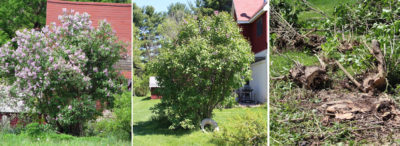
Young lilac, old lilac, renovated lilac
I’ve pruned my lilac over the years, but — I have to admit — never cut the old stems close enough to the ground nor thinned out the many young stems sufficiently. (My excuse is that the dense crowding of 5-inch-diameter stems made cutting difficult, the difficulty made more so by the haven they provided for poison ivy vines.)
A non-blooming lilac shrub isn’t worth keeping, so drastic renovation was in order. This treatment can be applied to any old, decrepit shrub. It’s easy. All that’s needed is to cut everything to the ground. Which I did.
My lilac’s stumps gave evidence to the shrub’s poor showings over the years with their many thick yet half-rotten, old stubs. Shrubby stems, as I wrote, just aren’t meant to live that long, and over time can’t support good flowering.
If all goes well, new sprouts should soon poke up from ground level, vigorous new sprouts because they’ll be fueled by a large, old root system. It’ll be a few years before any of those sprouts get old enough to start flowering. But I’ll make sure to thin them out so each has room to develop. I promise.
Win a Copy of My Book
A few weeks ago my plum tree was in full bloom, actually only part of it was in full bloom. Winter’s wacky weather? Spring’s wacky weather?  Offer an explanation and, if correct, you’ll be in the pool of readers, one of whom, randomly selected, gets sent a free copy of my book Grow Fruit Naturally. Respond by midnight, May 31st.
Offer an explanation and, if correct, you’ll be in the pool of readers, one of whom, randomly selected, gets sent a free copy of my book Grow Fruit Naturally. Respond by midnight, May 31st.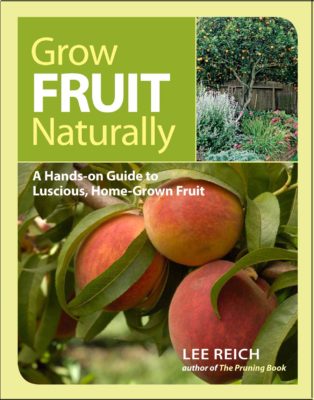
WEEDS (SOME GOOD)
/2 Comments/in Gardening, Pests, Tools/by Lee ReichAnti-Weed Tools
Recently sown vegetable seeds that have sprouted are growing slowly; weeds and lawn are growing fast. Give weeds an inch, and they’ll take a mile. Ignore growing lawngrass, and soon you’ll need a tractor or a scythe to cut it down to size.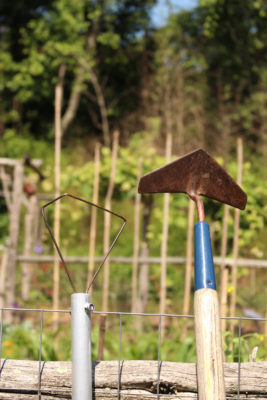
But few people ignore their lawns. Dealing with the growing grass is straightforward: You get out the lawnmower and go back and forth or round and round until every grass blade has been sheared.
Weeding demands more thought, technique, and intimacy with vegetation. Different weeds and different settings call for different approaches. In a vegetable garden, a hoe might be the tool of choice. My choices for hoes are the winged weeder, with a sharp blade that runs parallel to the ground surface and just slightly below ground in use, and the wire weeder, whose wire performs similarly.
Mostly, though, I don’t need or use a hoe in my “weedless” (actually, “weed-less”) vegetable garden. Weeds are few enough and the soil is soft enough so that all that’s necessary is to bend over and pull out a weed, tops and all. Tap-rooted weeds, such as dandelion, need coaxing out with the aid of a trowel or hori-hori knife. That coaxing also helps lift a quackgrass plant gently enough to allow following its subterranean runner as far as possible until it breaks.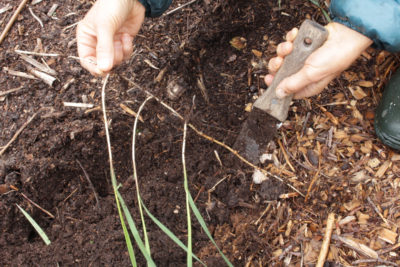
Along garden edges, my half-moon edger is very good at scouring out a dry moat that stops weed. Problem is that my garden has a lot of edges. And furthering the problem, any edges neglected for more than a couple of weeks during a spell of good growing conditions puts that edge back to square one.
Fire and Acid
Just outside the glass sliding doors of my living room is a brick terrace that makes a nice take-off point to a short expanse of lawn and then, through an arbor, into the main vegetable garden. Or, turning, south, towards the greenhouse and meadow. You’d think that the brick surface of the terrace would be maintenance- and weed-free. Not so.
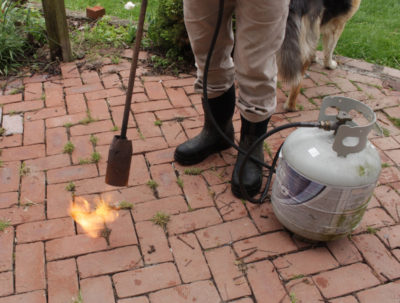 It’s a tribute to the tenacity of weeds how they manage to take root or sprout, and then thrive, in the small openings between adjacent bricks. Even in the small cracks between the bricks and the masonry wall of the house. Some of those “weeds” are actually welcome there — such as the wild columbines that send up thin stalks at the ends of which hover orange and yellow blossoms whose rear-pointing spurs gives the flowers the appearance of flaming rockets.
It’s a tribute to the tenacity of weeds how they manage to take root or sprout, and then thrive, in the small openings between adjacent bricks. Even in the small cracks between the bricks and the masonry wall of the house. Some of those “weeds” are actually welcome there — such as the wild columbines that send up thin stalks at the ends of which hover orange and yellow blossoms whose rear-pointing spurs gives the flowers the appearance of flaming rockets.
Still, most of those weeds have to go. Pulling them out individually would be too tedious, and takes with them what little dirt or rock dust lies between the bricks. So I torch them, instead. A small, hand-held torch would be effective, but slow. I use the appropriately named Dragon Weeder, whose 3-inch diameter nozzle attaches, via a 10-foot long hose, to a 20 gallon propane tank. Fire roars out of this dragon’s mouth like a jet engine, and all that’s needed is a quick pass. No need to set plants on fire; just heat them enough to burst their cells. And this wet day is ideal to reduce the risk of fire spreading.
Equally effective for an expanse like my terrace is to burn foliage with vinegar. Household vinegar, straight up (5 or 6% acetic acid), does the trick as long as the temperatures are above 70°F. Effectiveness is increased if 2 tablespoons per gallon of canola oil and 1 tablespoon per gallon of liquid soap is added to the vinegar, and if vegetation is not so large as to cause “shadows” where lower vegetation gets bypassed.
Either fire or vinegar kills only the tops of plants. Roots might have sufficient stored energy to send up new sprouts, so treatments must be repeated until roots have used up all their energy.
Weed Food
Corn salad is considered a weed in Europe. It’s borderline weedy in my garden, with its tufts of greenery clustering near the foot of some of my vegetable beds and occasionally elsewhere.
No need to hoe it, hori-hori it, torch it, or vinegar corn salad. I let it be, even coax it along, in some areas, and weed it out in others. Corn salad and I can maintain this congenial relationship because I like to eat it.
The same can be said for Good King Henry, another European import that could take over my garden if given free rein. It’s a relatively unknown relative of more familiar edibles like lamb’s-quarters (Chenopodium album), epazote (C. ambrosioides), and quinoa (C. quinoa), and, to me, the best-tasting of the lot. Even if you didn’t like the flavor of Good King Henry, you couldn’t help loving its botanical name, C. bonus-henricus. Eat it and weed.

